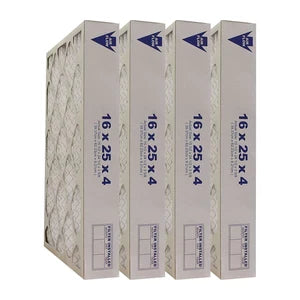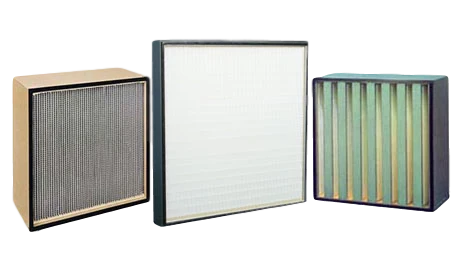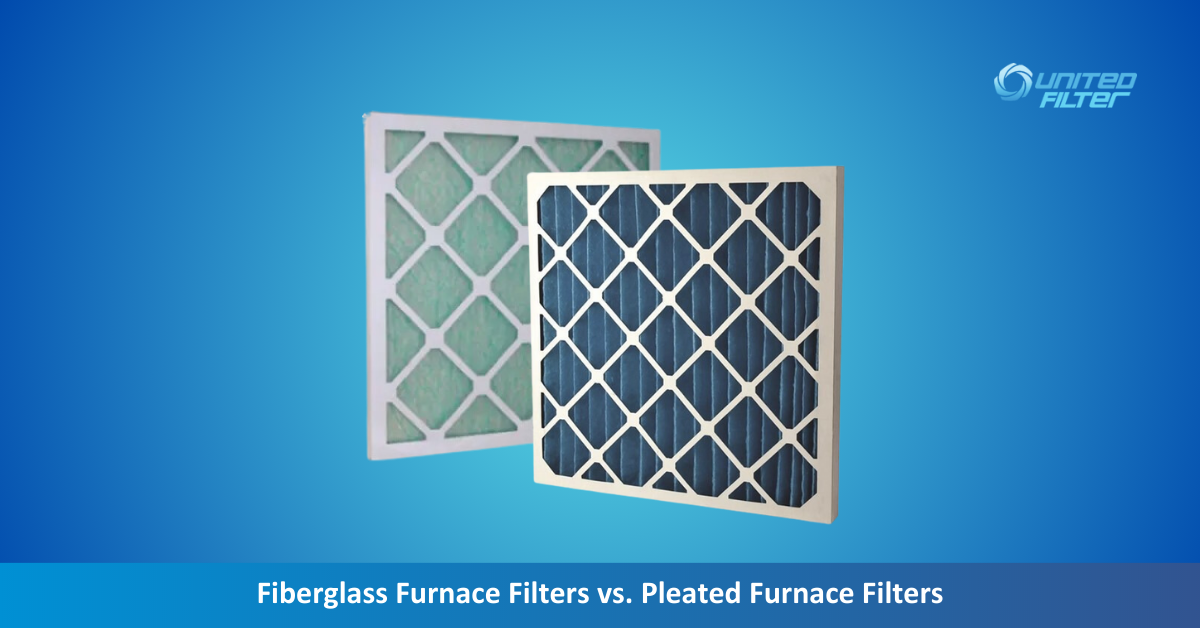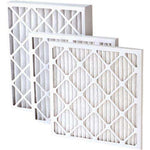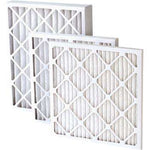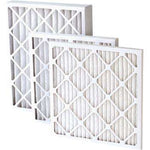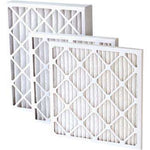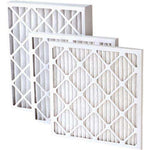You have no items in your shopping cart.
| Feature | Fiberglass Furnace Filters | Pleated Electrostatic Filters |
|---|---|---|
| Material | Fiberglass | Polyester or cotton |
| Efficiency | Low | Medium to high |
| Lifespan | 1-3 months | 3-6 months |
| Allergen Protection | Limited | Better |
| Maintenance | Frequent replacement | Last Longer |
| Environmental Impact | Not eco-friendly | More eco-friendly |
| Cost | Inexpensive | More expensive |
When it comes to maintaining the air quality in your home and protecting your HVAC system, choosing the right furnace filter is crucial. Fiberglass furnace filters and pleated furnace filters are two popular options available in the market, each with its unique set of advantages and disadvantages. In this comprehensive guide, we will delve deeper into the key differences between these two filter types, comparing their efficiency, lifespan, ease of use, environmental impact, and cost to help you make an informed decision that suits your needs and preferences.
Fiberglass Filters
Fiberglass furnace filters, also known as disposable filters, are an affordable option made from layers of fiberglass material. These filters are designed to protect your HVAC system from large particles such as dust, lint, and debris. They are the most basic type of filter and are often used as the default choice in many HVAC systems.Pros:
-
Inexpensive: Fiberglass filters are the most cost-effective option, making them suitable for homeowners on a tight budget.
-
Easy to install and replace: These filters are lightweight and simple to handle, making installation and replacement a breeze.
-
Protects HVAC system: Despite being less efficient in trapping small particles, fiberglass filters still protect the HVAC system from larger debris, which can cause damage and reduce efficiency.
Cons:
-
Low efficiency in trapping small particles: Fiberglass filters have a low MERV rating, meaning they are not very effective in capturing smaller particles like pollen and pet dander.
-
Short lifespan: These filters need to be replaced frequently, usually every 1-3 months, which can add up in cost over time.
- Not environmentally friendly: Due to their short lifespan and disposable nature, fiberglass filters contribute to waste and are not an eco-friendly choice.
Pleated Electrostatic Furnace Filters
Pleated Electrostatic Furnace Filters are made from layers of polyester or cotton that are folded into pleats, providing a larger surface area for filtration. These filters are more effective at trapping both large and small particles, including dust, pollen, and mold spores. They are a better option for those with allergies or asthma, as well as those who want to improve the overall air quality in their homes.Pros:
-
Higher efficiency in trapping particles: Pleated filters have a higher MERV rating, making them more effective at capturing small particles and providing better indoor air quality.
-
Longer lifespan: With a typical lifespan of 3-6 months, pleated filters last longer than fiberglass filters, reducing the frequency of replacements.
-
Available in various MERV ratings: Homeowners can choose from a range of MERV ratings based on their specific filtration needs and preferences.
- Better allergen protection: Pleated filters are better at capturing allergens such as pollen, pet dander, and mold spores, making them suitable for allergy sufferers or those with respiratory issues.
Cons:
- Pleated Electrostatic Furnace Filters are Expensive: While pleated filters offer better performance, they are more costly upfront.
- Requires more frequent maintenance: These filters need to be cleaned or replaced regularly to maintain optimal efficiency and prevent strain on the HVAC system.
Conclusion
When choosing between fiberglass and pleated electrostatic furnace filters, consider your specific needs and priorities. If you are looking for an affordable option with minimal maintenance, fiberglass filters may be the right choice. However, if you require higher efficiency filtration, better allergen protection, and a longer lifespan, pleated electrostatic furnace filters are a better investment. By understanding the differences between these filter types, you can make an informed decision that ensures cleaner air and a more comfortable living environment.
| Feature | Fiberglass Furnace Filters | Pleated Electrostatic Filters |
|---|---|---|
| Material | Fiberglass | Polyester or cotton |
| Efficiency | Low | Medium to high |
| Lifespan | 1-3 months | 3-6 months |
| Allergen Protection | Limited | Better |
| Maintenance | Frequent replacement | Last Longer |
| Environmental Impact | Not eco-friendly | More eco-friendly |
| Cost | Inexpensive | More expensive |
When it comes to maintaining the air quality in your home and protecting your HVAC system, choosing the right furnace filter is crucial. Fiberglass furnace filters and pleated furnace filters are two popular options available in the market, each with its unique set of advantages and disadvantages. In this comprehensive guide, we will delve deeper into the key differences between these two filter types, comparing their efficiency, lifespan, ease of use, environmental impact, and cost to help you make an informed decision that suits your needs and preferences.
Fiberglass Filters
Fiberglass furnace filters, also known as disposable filters, are an affordable option made from layers of fiberglass material. These filters are designed to protect your HVAC system from large particles such as dust, lint, and debris. They are the most basic type of filter and are often used as the default choice in many HVAC systems.Pros:
-
Inexpensive: Fiberglass filters are the most cost-effective option, making them suitable for homeowners on a tight budget.
-
Easy to install and replace: These filters are lightweight and simple to handle, making installation and replacement a breeze.
-
Protects HVAC system: Despite being less efficient in trapping small particles, fiberglass filters still protect the HVAC system from larger debris, which can cause damage and reduce efficiency.
Cons:
-
Low efficiency in trapping small particles: Fiberglass filters have a low MERV rating, meaning they are not very effective in capturing smaller particles like pollen and pet dander.
-
Short lifespan: These filters need to be replaced frequently, usually every 1-3 months, which can add up in cost over time.
- Not environmentally friendly: Due to their short lifespan and disposable nature, fiberglass filters contribute to waste and are not an eco-friendly choice.
Pleated Electrostatic Furnace Filters
Pleated Electrostatic Furnace Filters are made from layers of polyester or cotton that are folded into pleats, providing a larger surface area for filtration. These filters are more effective at trapping both large and small particles, including dust, pollen, and mold spores. They are a better option for those with allergies or asthma, as well as those who want to improve the overall air quality in their homes.Pros:
-
Higher efficiency in trapping particles: Pleated filters have a higher MERV rating, making them more effective at capturing small particles and providing better indoor air quality.
-
Longer lifespan: With a typical lifespan of 3-6 months, pleated filters last longer than fiberglass filters, reducing the frequency of replacements.
-
Available in various MERV ratings: Homeowners can choose from a range of MERV ratings based on their specific filtration needs and preferences.
- Better allergen protection: Pleated filters are better at capturing allergens such as pollen, pet dander, and mold spores, making them suitable for allergy sufferers or those with respiratory issues.
Cons:
- Pleated Electrostatic Furnace Filters are Expensive: While pleated filters offer better performance, they are more costly upfront.
- Requires more frequent maintenance: These filters need to be cleaned or replaced regularly to maintain optimal efficiency and prevent strain on the HVAC system.
Conclusion
When choosing between fiberglass and pleated electrostatic furnace filters, consider your specific needs and priorities. If you are looking for an affordable option with minimal maintenance, fiberglass filters may be the right choice. However, if you require higher efficiency filtration, better allergen protection, and a longer lifespan, pleated electrostatic furnace filters are a better investment. By understanding the differences between these filter types, you can make an informed decision that ensures cleaner air and a more comfortable living environment.
